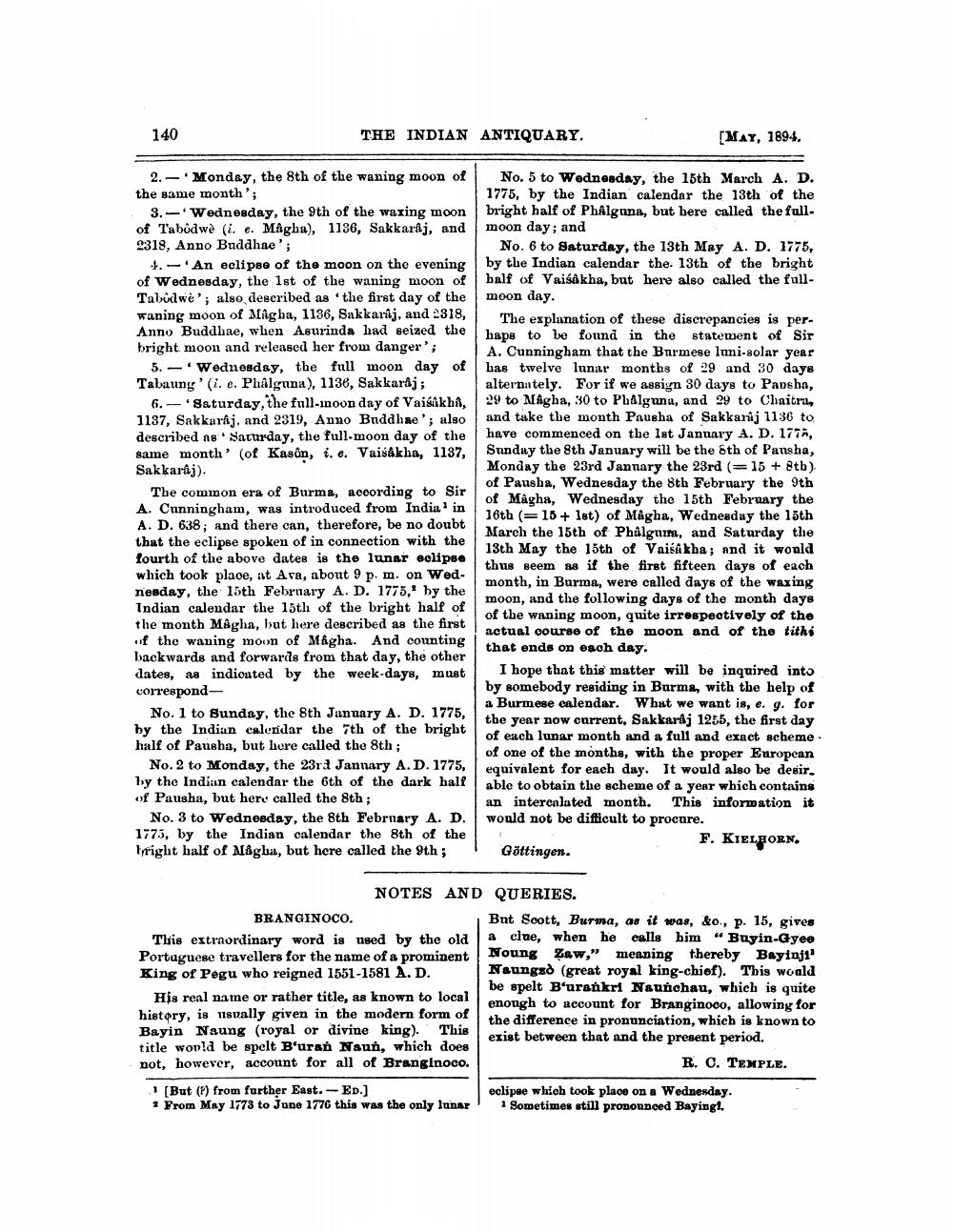________________
140
THE INDIAN ANTIQUARY.
[MAY, 1894.
2.- Monday, the 8th of the waning moon of No. 5 to Wednesday, the 15th March A. D. the same month';
1775, by the Indian calendar the 13th of the 3. Wednesday, the 9th of the waxing moon bright half of PhAlguna, but here called the full. of Tabödwe (i. e. Magha), 1136, Sakkaráj, and moon day; and 2318, Anno Buddhae';
No. 6 to Saturday, the 13th May A. D. 1775, 1.- An eclipse of the moon on the evening by the Indian calendar the. 13th of the bright
Vadna day, the 1st of the waning moon of balf of Vaisakha, but here also called the fullTabòdwe'; also described as the first day of the moon day. waning moon of Magha, 1136, Sakkarij, and 2318, The explanation of these discrepancies is perAnno Buddhae, when Asurinda had seized the hape to be found in the statement of Sir bright moon and released her from danger';
A. Cunningham that the Burmese luni-solar year 5.- Wednesday, the full moon day of bas twelve lunar months of 29 and 30 days Tabaung' i.e. Phâlguna), 1138, Sakkaraj; alternately. For if we assign 30 days to Paysha,
6.- Saturday, the full-inoon day of Vaisikha, 29 to Nagba, 30 to Phålguna, and 29 to Chaitri, 1137, Sakkuraj, and 2319, Anno Buddhae'; also and take the month Pausha of Sakkaraj 1136 to described ag Saturday, the full-moon day of the have commenced on the 1st January A. D. 1778, same month' (of Kasan, i.e. Vaisakha, 1137, | Sunday the 8th January will be the 6th of Pansha, Sakkaraj).
Monday the 23rd Jannary the 23rd (= 15 + 8tb)
of Pausba, Wednesday the 8th February the 9th The common era of Burma, according to Sir
of Mâgha, Wednesday the 15th February the A. Cunningham, was introduced from India.in
16th (=15+ lst) of Mâgha, Wednesday the 15th A. D. 638; and there can, therefore, be no doubt
March the 15th of Phålguin, and Saturday the that the eclipse spoken of in connection with the
13th May the 15th of Vaisakha; and it wonld fourth of the above dates is the lunar eclipse
thus seem as if the first fifteen days of each which took plaoe, at Ara, about 9 pm. on Wed.
month, in Burma, were called days of the waxing nesday, the 15th February A. D. 1775,' by the
moon, and the following days of the month days Indian calendar the 15th of the bright half of
of the waning moon, quite irrespectively of the the month Magha, but here described as the first
actual course of the moon and of the tithi of the waning moun of Magha. And counting
that ends on each day. backwards and forwards from that day, the other dates, as indioated by the week-days, must
I hope that this matter will be inquired into correspond
by somebody residing in Burma, with the help of
a Burmese calendar. What we want is, e. g. for No.1 to Sunday, the 8th January A. D. 1775,
the year now current, Sakkaraj 1255, the first day by the Indian calcridar the 7th of the bright
of each lunar month and a full and exact scheme half of Pausha, but here called the 8th;
of one of the months, with the proper European No.2 to Monday, the 23rd Jannary A.D. 1775,
equivalent for each day. It would also be desir. hy the Indian calendar the 6th of the dark half
able to obtain the scheme of a year which contains of Pausha, but here called the 8th;
an intercalated month. This information it No. 3 to Wednesday, the 8th February A. D. would not be difficult to procure. 1775, by the Indian calendar the 8th of the
F. KIELPORN. Irright half of Megha, but here called the 9th ; Göttingen.
NOTES AND QUERIES. BRANGINOCO.
Bnt Scott, Burma, as it was, &o., p. 15, gives This extraordinary word is used by the old
a clue, when he calls him “Buyin-Gyee Portuguese travellers for the name of a prominent
Noung Law," meaning thereby Bayinji' King of Pegu who reigned 1551-1581 A. D. Naungad (great royal king-chief). This would
be spelt Bʻurankri Nauńchau, which is quite His real name or rather title, as known to local
enough to account for Branginooo, allowing for history, is usually given in the modern form of
the difference in pronunciation, which is known to Bayin Naung (royal or divine king). This
exist between that and the present period. title wonld be spelt Bʻuran Naun, which does not, however, account for all of Branginoco.
R. C. TEMPLE.
1 (But (P) from further East.- ED.)
eclipse which took place on a Wednesday. 1 From May 1778 to June 1776 this was the only lunar' Sometimes still pronounced Bayingi.




